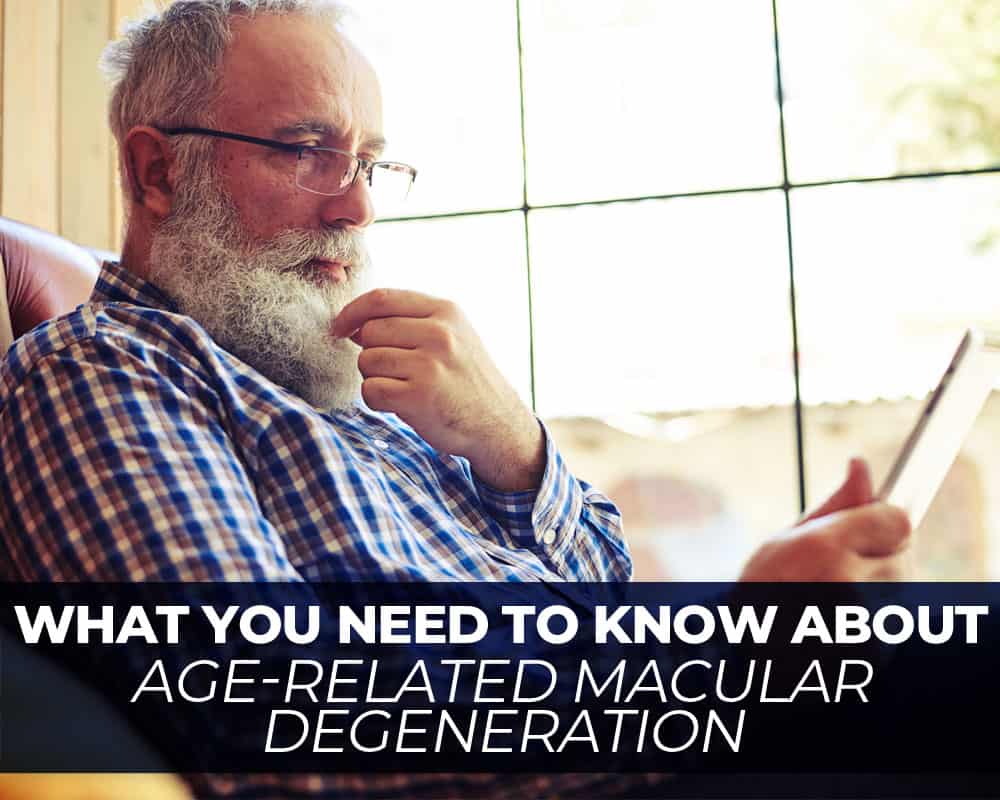Home » Blog » What You Need To Know About Age-Related Macular Degeneration
What You Need To Know About Age-Related Macular Degeneration
Posted by: Center for Sight in Uncategorized, November 26, 2018

Age-related macular degeneration, otherwise known as AMD, is a condition that often causes severe and irreversible vision loss in people over the age of 60-years-old. During this time, a small portion of the retina – called the macula – begins to deteriorate. This condition is very common and, in fact, is literally the leading cause of severe vision loss for people who fall into this age range.
While it’s certainly true that AMD will almost never cause a person to go totally blind, the level of visual impairment that they’re expected to experience will likely be significant if the condition is allowed to advance untreated. If you or a loved one thinks that you may be coming down with AMD, or if you’re just eager to learn more about it so that you’re in a better position to recognize certain warning signs and symptoms when your own time comes, there are a few key things you’ll want to keep in mind.
Who is at Risk of AMD?
As the name suggests, one of the major contributing risk factors to age-related macular degeneration is exactly that: your age. Generally speaking, people over the age of 60 are far more likely to come down with this condition.
That’s not the only risk factor, however – far from it. Genetics also play an important role. If you have a family history of AMD, your chances are much higher at coming down with it yourself. Likewise, certain lifestyle choices like cigarette smoking and even obesity can significantly impact the probability that you will become afflicted. Finally, conditions like hypertension are major indicators of a much more serious problem lurking just beneath the surface – which are all reasons why it pays to be proactive about your health whenever possible.
What are the Common Symptoms of AMD?
There are two main types of AMD to concern yourself with – dubbed “wet” and “dry” due to their nature. Wet AMD involves abnormal blood vessels under the retina that begin to grow towards the macula and account for roughly 90% of all cases of severe vision loss. The cause of dry AMD is not actually known, and it tends to progress far more slowly. One of the first symptoms of dry AMD is a series of small white or yellow-colored deposits that form on the retina, beneath the macula.
In either situation, some of the first symptoms you are likely to notice include dark and/or blurry areas that appear in the center of your vision. In very rare situations, you may actually experience a noticeable change in how you perceive colors in the world around you.
Diagnosing AMD
In order to properly diagnose someone with AMD, doctors will usually order one of two different tests. The first is an OCT, or “optical coherence tomography.” This involves taking a very special type of photograph that essentially allows a doctor to view a full 3D image of your eye’s retina. Using this photograph, doctors can see if the layers are distorted, and they can also better see if any swelling is present and whether or not it is getting worse over time.
Another common type of test used to diagnose AMD is called the fluorescein angiography. During this, a doctor will inject a very particular type of dye into the arm of a patient and will then track that die as it flows through the blood vessels of the retina. This too will shed valuable insight into what is going on to cause any vision problems someone is experiencing and, more importantly, why they’re occurring.
The Treatment of AMD
While it’s certainly true that there is no cure for AMD, the good news is that there is a wide range of viable treatment options available depending on the patient and the severity of the condition that they’re experiencing. This can include but is not limited to things like:
- Laser therapy.
- Anti-angiogenic drugs, which are drugs that a doctor will inject directly into a person’s eye to stop new blood vessels from forming.
- Vitamins like vitamin C, vitamin E, beta-carotene, zinc and copper.
- Submacular surgery, which is a special type of surgery that will allow a surgeon to remove abnormal blood vessels.
- Retinal translocation, which is a procedure that will actually destroy abnormal blood vessels.
The key thing to understand is that there is no “one size fits all” approach to successfully treating AMD. Everyone is a little bit different and oftentimes the best and most beneficial course of action will depend on the person who has been afflicted by the disease and what is best for their own lifestyle and long-term recovery chances.
